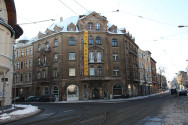
Off-grid community in Leipzig

Sustainability and pursuing the eco dream is no easy feat when living in the heart of a major European city. High rents, cramped living, pollution, noise, expensive transport, capitalistic commerce. But there can be ways to flourish in a co-operative without money (or electricity), to live decently, to expand, to breathe. I got a taste of how to live off-grid in a comfortable mansion on a recent visit to Leipzig.
Just an hour south of Berlin, Leipzig is a city of over 500,000 people crawling out of the shadow of its big brother. As the young creatives and professionals of Western Europe are packing up and moving to Berlin in search of a sustainable artistic life, Leipzig is being bypassed by migrators. The city has been given several nicknames over the past few years, notably “Little Berlin” and “Hypezig” -for good reason. It is an artistic haven also known as the “City of Music”. It has history; Johann Sebastian Bach was choirmaster at St. Thomas’ Kirche for more than 25 years. Mendelssohn and Schumann also spent time in the city.
I travelled out to Leipzig for the second time last autumn and found myself living in a communal building in the artistic quarter of Lindenau. Upon arrival I discovered the exterior of the building to be formidable and mildly disconcerting. Graffiti clad and poster covered, the house also had kid’s toys mounted on either side of the front door. Where there could have been stone lions guarding the entrance, there were My Little Ponies in their place. This is an artist’s home.
The use of space is what made the building so efficient and multi-functionL. After the collapse of the wall hawk-eyed Western Germans bought up large areas of Leipzig and began the capitalist rejuvenation of the city in 1989. The landlord of our building However, was a mythical creature that had been heard of but never seen. The occupants of the space basically had free reign and had spent the last few decades making the building their own.
There were three other guys on my floor of the building, Max, Marcel and David. Max was an arborist and had been living in the building longest. Along with help from Marcel, they had built and installed a coal burning system that heated the whole floor. Each room had its own stove that was built from clay and raised on blocks above the wood flooring. Coal and wood were used as fuel and smoke was funnelled out through a pipework system. Left to heat up for half a day and then constantly re-fuelled, this provided more than enough heat. Wood burning ovens were also employed to cook both in the kitchen and in the rear garden. Coal was stored in the cellar where it could be kept dry and in mass.
As an arborist, Max had access to an abundance of …